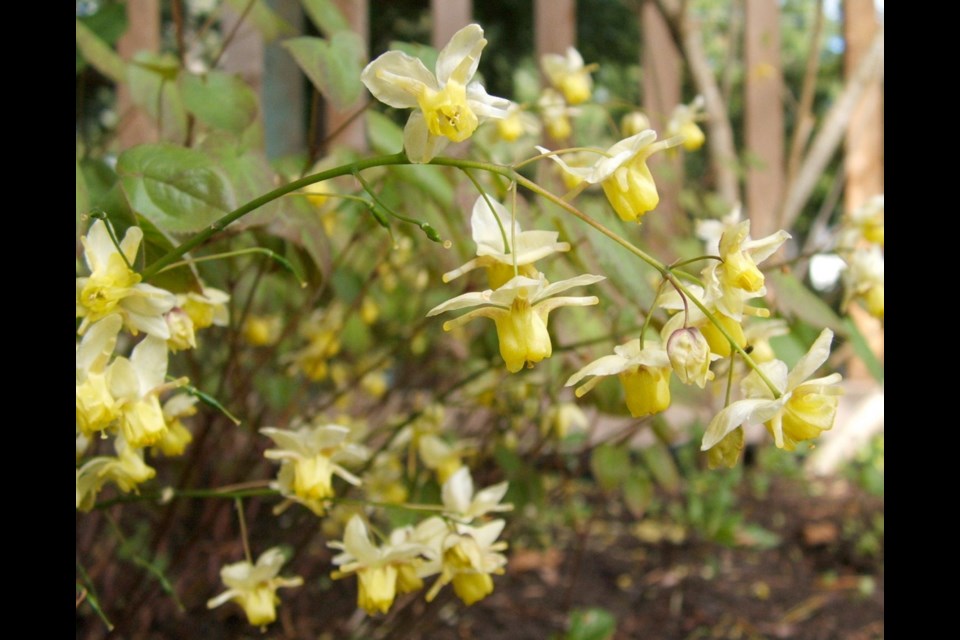Dear Helen: I am looking for plants that grow under 60 cm high, are deer resistant, and will do well in dry soil that gets little sun.
A.W.
Before I suggest suitable plants, a note about deer: The plants I suggest are ones that deer don’t usually prefer to eat. In hungry times, however, they’ll eat almost anything.
Consider looking among native ground cover plants such as salal and low-growing Oregon grape. The Oregon grape (Mahonia nervosa) has holly-like leaves and clusters of bright yellow spring flowers followed by blue berries that can be made into jelly or syrup.
Salal (Gaultheria shallon) is widely variable in height, but the plants are easy to keep under 60 cm. It has thick, leathery leaves, pink-tinged, urn-shaped flowers in spring and dark purple summer berries that can be made in to jam.
Both these native evergreen shrubs grow throughout my garden, which was carved out of woodland. They thrive in sunny and shaded places, and grow in areas that are not watered. Both spread on creeping roots. Garden Centres that carry native plants will likely have them.
On drought tolerance: My salal and Oregon grape survive easily in dry places because they are long established. When introducing “drought tolerant’ plants to a garden, you need to prepare the ground well and water regularly for at least the first year, while the plants grow extensive, drought-resistant root systems.
If you prefer cultivated garden plants, hardy geranium and epidedium are good choices. Geranium macrorrhizum (bigroot cranesebill) is a superb grow-anywhere plant. It forms a dense, low ground cover of fragrant leaves. Flowers, usually pink, appear in late spring and early summer.
Epimedium (barrenwort, bishop’s hat) is equally tough, creating a beautiful ground cover of heart-shaped leaves even in dry shade under greedy-rooted trees. My plantings stay lovely year round. They produce sprays of flowers like miniature columbines in spring.
Dear Helen: I am growing potatoes for the first time and am puzzled by flowers appearing on the plants. Does this mean they are “bolting” to seed? Should I cut them off?
K.G.
No. Leave them. Flowers are part of their natural cycle. They usually indicate that the first small tubers may have formed. When seasoned gardeners see flowers on the plants, they often begin rooting carefully, by hand, in the soil beneath the outer leaf tips of the plants to feel for a few baby potatoes. Take care to disturb the plants as minimally as possible.
Dear Helen: Is it true that Cardiocrinum takes 10 years to bloom?
D.C.
No. It takes up to seven years from seeding to bloom. After flowering, the bulb dies, leaving behind offsets that will take three or four years to bloom.
Cardiocrinum giganteum grows to around four metres high with large, heart-shaped leaves and an enormous spike of white trumpet flowers. Commonly called Giant Himalayan Lily, it needs a deep, humus-rich soil that is kept moist in summer.
Dear Helen: I enjoyed your column on slugs and noted the “beer trap” you described, made with a covered cottage cheese or sour cream container with holes cut under the rim, filled three-quarters full of stale beer. Why not just sink fairly deep, open saucers or plant trays of beer into the ground?
S.M.
Rain and watering the garden will quickly dilute the beer in an uncovered trap, and ground beetles, which are valued slug predators, can fall into the open trays and drown.
Dear Helen: I planted potatoes in a bag designed for the purpose. They grew fast, and the stems are now so long that they are on the verge of falling over. What should I do? I planted the seed potatoes deep down in the bag and gradually filled in around the growing stems with planting mix and then straw.
B.G.
There are several possible causes of the overlong stems. Some varieties grow more vigorously than others. Over-watering or/and feeding with a high-nitrogen fertilizer will promote soft, lush, over-long growth.
The unusual weather through the spring has fostered the same sort of growth. Such frequent rains and cool temperatures don’t usually persist through May and June. It’s more common for May to bring warm, sunny weather to help harden and mature the first, lush growth of spring.
Finally, the long growth could also be simply part of the container-grown potato experience. Potatoes I’ve grown in bags have tended to produce unusually elongated stems.



